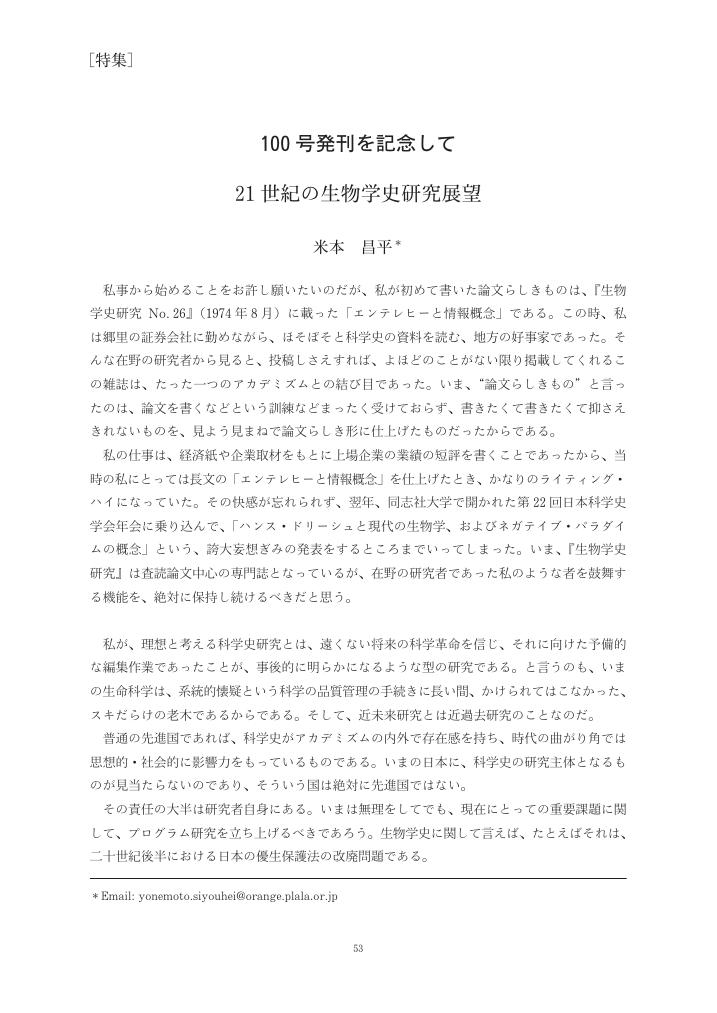12 0 0 0 OA 放射線影響研究と防護基準策定に関する科学史的研究
本研究は、放射線影響をめぐる科学的な調査研究について、その形成と展開を歴史的に解明するとともに、それらが国際機関等の場でどのように評価され、防護基準の策定にいかにいかされたのかの経緯を解明することを目的とし、広島・長崎の原爆被害者に対する調査研究からチェルノブイリや福島の原発事故による影響まで、科学史を軸に据えつつ、歴史と現状の両面から、学際的に研究を進めてきた。他のグループとの共催のものも含め、学会等でのシンポジウムや公開の国際ワークショップを含めた複数の研究会合等を企画・開催し、研究成果の発表を行なうことができた。
5 0 0 0 OA ビキニ被災情報の国際的伝達と各国の原子力開発への影響
1954年3月の米国のビキニ水爆実験によって、第五福竜丸の乗組員が放射線被害を被った。その実態は、自らも調査に関わった当時大阪市立医科大学助教授だった西脇安によって各国に伝えられた。本研究では、遺族から提供された資料などの分析で、次のことが明らかにされた。(1)1954年の西脇の欧州訪問は、大阪の原水爆禁止運動が財政的に支えたこと。(2)訪欧中のジョセフ・ロートブラットとの出会いが、1955年の「ラッセル・アインシュタイン宣言」の重要なきっかけを与えたこと。(3)1957年のソ連及び東欧訪問でその影響が広がったこと。(4)1959年の訪米によってライナス・ポーリングの反核運動を支えたこと。
4 0 0 0 放射線生体影響に関する物理学、疫学、生物学の認識文化の比較分析
社会調査G:アンケート項目を作成し、491人の放射線の研究者(10の学会、6のML)にアンケートを実施し、結果の分析を行った。その結果、交流人数が多い人は放射能汚染のリスクを低く評価していることが認められた。交絡因子によるものかどうかを精査することによって、これらの関係がより明確になるが、これはH30年度実施予定の項目を改善し、大規模で実施するアンケートで確かめていきたい。また、異分野交流の人数が多い人は放射線に関する知識量も多い傾向がみられた。参与観察G:環境科学研究所、ノースウエスタン大学に赴き、研究所(室)の概要についてのインタビューを実施した。また分野を横断する試みを行っている研究会(iCEM リトリート研究会等)に参加し、分野横断の試みについて調査した。歴史研究G:分野横断研究を行った研究者(和田昭允・永宮正治・安斎育郎))のインタビュー調査を行い、文章化し、推敲を行い、発表できる目処が立った。
2 0 0 0 OA 3 「反核」「平和」と原爆被害をめぐる言説
- 著者
- 中尾 麻伊香
- 出版者
- 日本平和学会
- 雑誌
- 平和研究 (ISSN:24361054)
- 巻号頁・発行日
- vol.57, pp.57-79, 2021 (Released:2022-01-31)
- 参考文献数
- 47
- 被引用文献数
- 1
原爆被害をめぐる言説は、「反核」や「平和」に関する言動とどのように関わっていたのだろうか。原爆被害が隠されたとされる占領期と原爆被害の実相が明らかにされてきた1950年代を中心に、メディアにおける原爆被害をめぐる言説を検討した本論文は、それらの言説が被爆者の苦しみを生み出した側面を指摘している。原爆投下後の被爆地では、復興の文脈で原爆と「平和」が結びつき、科学の進歩や原子力の平和利用への希求の中、原爆被害は乗り越えたものとされた。占領終結後、原爆被害は全国的に知られるようになるが、それは過去の戦争の惨禍として受け取られた。1954年、アメリカの水爆実験による第五福竜丸の被災を契機に全国的な原水爆禁止運動が起こり、原爆被害への人々の関心の高まりとともに、被害者の援護も進んだ。このとき人々が反対したのは核の軍事利用であり、「平和」利用への道を揺るがせるものではなかった。原水爆禁止運動は、核兵器の恐ろしさを強調することで、とりわけ放射線被ばくと奇形を結びつけ、被爆者差別を助長した。すなわち占領期には原子力「平和」利用への希求が、占領終結後の1950年代には「反核」運動が、原爆被害の不可視化、可視化に関わり、被爆者の苦しみを生み出していた。平和を希求する私たちには、言説の背後の多様性と、言説によって生み出されるものへの想像力を働かせながら、なおも言説を紡いでいくという難題が課せられている。
2 0 0 0 OA 近代化を抱擁する温泉―大正期のラジウム温泉ブームにおける放射線医学の役割
- 著者
- 中尾 麻伊香
- 出版者
- 日本科学史学会
- 雑誌
- 科学史研究 (ISSN:21887535)
- 巻号頁・発行日
- vol.52, no.268, pp.187-199, 2013 (Released:2021-07-12)
This paper examines how radiation medicine has contributed to the popularization of hot springs in modern Japan. In the early 20th century, radium was a precious material used for medical purposes, and people wanted to use it for therapeutic purposes as well as to enhance their health, without knowing about its harmful effects. Radium hot springs became fashionable in Japan and its colonies in the 1910s. The boom of "radium hot springs" was generated through the relationship between Japanese scholars, national policy, and local villages. In 1909, medical scientist Kaichiro Manabe, and physicist, Denichiro Ishitani, found "radium emanation" (radon) in several hot springs and reported that these highly reputed hot springs contained radium emanation. At the Atami hot spring, Manabe lectured that radium provided the real potency behind the hot spring and determined the hot spring's life and death. Manabe presented a modern scientific explanation for the hot spring's traditional values. As scholars reported that radium provided the real potency of hot springs, local hot spring villages seized on the scientific explanation and connected their developments with national policies. This paper illustrates how the discourse about radium, which came from the field of radiation medicine, connected traditional and modern values as well as the central and regional terrains.
1 0 0 0 OA 特集 100号発刊を記念して
1 0 0 0 OA イントロダクション
- 著者
- 中尾 麻伊香
- 出版者
- 日本科学史学会生物学史分科会
- 雑誌
- 生物学史研究 (ISSN:03869539)
- 巻号頁・発行日
- vol.95, pp.27-28, 2017-06-30 (Released:2019-06-03)
1 0 0 0 OA ABCC史を拓くストウ伝
- 著者
- 中尾 麻伊香
- 出版者
- 日本科学史学会生物学史分科会
- 雑誌
- 生物学史研究 (ISSN:03869539)
- 巻号頁・発行日
- vol.95, pp.29-34, 2017-06-30 (Released:2019-06-03)
本年度は研究目的のなかでも原爆投下以前から以後にかけて言説がどのように引き継がれ変容していったかという点を考察し、原爆投下以降を扱った先行研究との議論の接続を試みた。具体的には以下のように検討をすすめた。(1)原爆投下以降の原爆/原子力に関する言説を検討した。新聞や雑誌から、原爆/原子力に関する記述を調査し、その変遷を捉えた。この内容を2011年12月に東工大の火曜ゼミで「核をめぐる言説と日本の科学者:戦時中から戦後にかけて」というタイトルで報告した。(2)原爆調査に関する先行研究を整理し、原爆調査の歴史研究における課題を検討した。この内容を2011年9月に生物学史研究会夏の学校で「放射線をめぐる言説:原爆調査からビキニ事件まで」というタイトルで報告し、『生物学史研究』に投稿した。また、長崎原爆資料館、永井隆記念館、長崎大学医学部などで資料調査を行った。(3)1940年代後半の全国紙と地方紙にあらわれた原爆症に関する言説を検討した。原爆被害をめぐる言説が全国紙と地方紙で異なることを確認し、その背景にある力学を分析した。この内容を2012年3月にAssociation for Asian Studiesの年会で"Radiation Sickness, Popular Medical Discourse, and Social Discrimination in Early Postwar Japan"というタイトルで報告した。(4)研究目的の一つに挙げていたアーカイブへの貢献については、故・西脇安(放射線防護)の資料整理を行い、資料のアーカイブ化に尽力した。国際シンポジウム「核時代の記憶と記録-原爆アーカイブズの保存と活用-」に参加し、日米のアーキビストとの交流をはじめた。以上の研究と平行して、これまでに得られた成果をまとめ博士論文の執筆を開始した。
- 著者
- 中尾 麻伊香
- 出版者
- 青土社
- 雑誌
- ユリイカ (ISSN:13425641)
- 巻号頁・発行日
- vol.42, no.14, pp.152-159, 2010-12


